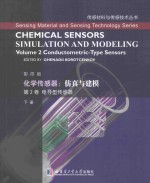

化学传感器 仿真与建模 第2卷 电导型传感器 下 英文PDF电子书下载
- 电子书积分:15 积分如何计算积分?
- 作 者:GhenadiiKorotcenkov主编
- 出 版 社:哈尔滨:哈尔滨工业大学出版社
- 出版年份:2015
- ISBN:9787560349039
- 页数:486 页
7 EXPERIMENTAL INVESTIGATION AND MODELING OF GAS-SENSING EFFECT IN MIXED METAL OXIDE NANOCOMPOSITES&L.I.Trakhtenberg G.N.Gerasimov V.F.Gromov M.A.Kozhushner O.J.Лegbusi 261
1 Introduction 261
2 Types of Mixed Metal Oxides 263
3 Synthesis of Metal Oxide Nanocomposites 264
4 Charge Transfer Processes and Conductivity 265
5 Conductivity Mechanism 267
6 Sensor Properties 269
7 Mechanism of Sensor Effect 272
7.1 Sensors Based on Single Nanofibers 272
7.2 Polycrystalline Sensors 275
8 Modeling of the Sensory Effect for Reduced Gases 283
8.1 Qualitative Discussion of the Sensory Mechanism 283
8.2 Equilibrium Electronic Characteristics Of SnO2 284
8.3 Sensor Response 285
9 Conclusions 290
Acknowledgment 291
References 291
8 THE INFLUENCE OF WATER VAPOR ON THE GAS-SENSING PHENOMENON OF TIN DIOXIDE-BASED GAS SENSORS&R.G.Pavelko 297
1 Introduction 297
2 Direct Water Effects on Tin Dioxide-Based Gas Sensors 299
2.1 Undoped SnO2 299
2.2 Doped SnO2 307
3 Indirect Water Effects on Tin Dioxide--Based Gas Sensors 310
3.1 Reducing Gases 311
3.2 Oxidizing Gases 322
4 Phenomenological Model 323
5 Conclusions 330
Acknowledgments 330
References 330
9 COMPUTATIONAL DESIGN OF CHEMICAL NANOSENSORS:TRANSITION METAL-DOPED SINGLE-WALLED CARBON NANOTUBES&Duncan J.Mowbray Juan Maria Garcia-Lastra Iker Larraza Arocena ?ngel Rubio Kristian S.Thygesen Karsten W.Jacobsen 339
1 Introduction 339
2 TM-Doped SWNTs as Nanosensors 342
3 Density Functional Theory 346
4 Kinetic Modeling 351
5 Nonequilibrium Green's Function Methodology 355
5.1 Divacancy Ⅱ 358
5.2 Divacancy Ⅰ 361
5.3 Monovacancy 363
5.4 Target and Background Molecules 364
6 Sensing Property 369
7 Conclusions 372
Acknowledgments 373
References 373
1O AL-DOPED GRAPHENE FOR ULTRASENSITIVE GAS DETECTION&Z.M.Ao Q.Jiang S.Li 379
1 Emerging Graphene-Based Gas Sensors 379
1.1 The Role of Aluminum Doping in Sensing Applications 380
2 Aluminum-Doped Graphene for CO Detection 381
2.1 Sensitivity Enhancement of CO Detection in Aluminum-Doped Graphene 381
2.2 Effect of Electric Field on CO Detection 387
2.3 Effect of Temperature on CO Detection 393
3 Aluminum-Doped Graphene for Formaldehyde Detection 399
3.1 Adsorption Enhancement with Aluminum Doping 399
3.2 Variation of Electronic Properties Induced by Adsorption 402
4 Aluminum-Doped Graphene for Detection of HF Molecules 404
4.1 Adsorption Enhancement of Aluminum-Doped Graphene 406
4.2 Adsorption Enhancement Mechanism 410
4.3 Effect of Electric Field on Adsorption 410
5 Conclusion and Future Challenges 411
Acknowledgments 413
References 413
11 PHYSICS-BASED MODELING OF SNO2 GAS SENSORS WITH FIELD-EFFECT TRANSISTOR STRUCTURE&P.Andrei L.L.Fields A.J.Soares R.J.Perry Y.Cheng P.Xiong J.P.Zheng 419
1 Introduction 419
2 Physics-Based Modeling of the Nanobelts 421
3 Model Calibration 425
4 Analytical Model for Nanobelt Sensors 430
4.1 Case 1:Nanobelt with Ohmic Contacts in the Presence of Hydrogen 431
4.2 Case 2:Nanobelt with Ohmic Contacts in the Presence of Oxygen 435
4.3 Case 3:Nanobelt with Schottky Contacts in the Presence of Oxygen 439
5 Conclusion 440
Appendix:Fabrication and Experimental Data 441
References 443
12 MODELING AND SIMULATION OF NANOWIRE-BASED FIELD-EFFECT BIOSENSORS&S.Baumgartner M.Vasicek C.Heitzinger 447
1 Introduction 447
2 Homogenization 450
3 The Biofunctionalized Boundary Layer 452
3.1 The Site-Dissociation Model 453
3.2 Screening and Biomolecules 454
3.3 Summary 460
4 The Current Through the Nanowire Transducer 461
4.1 The Drift-Diffusion-Poisson System 461
4.2 Self-Consistent Simulations of Sensor Systems 462
5 Summary 464
Acknowledgment 465
References 465
INDEX 471
- 《数学物理方法与仿真 第3版》杨华军 2020
- 《通信电子电路原理及仿真设计》叶建芳 2019
- 《智能制造高技能人才培养规划丛书 ABB工业机器人虚拟仿真教程》(中国)工控帮教研组 2019
- 《微机原理与单片微机系统及应用 基于Proteus仿真》编者 2019
- 《物联网中的传感器》葛卫清著 2019
- 《大数据建模方法》张平文,戴文渊,黄晶编著 2019
- 《仿真模型枪大全》日本HobbyJAPAN著 2014
- 《基于MATLAB的机器人轨迹优化与仿真》李辉著 2018
- 《轻型飞机起落架着陆动力学仿真与试验技术》聂宏,薛彩军编著 2019
- 《抽象 推理 建模》杨明媚著 2019
